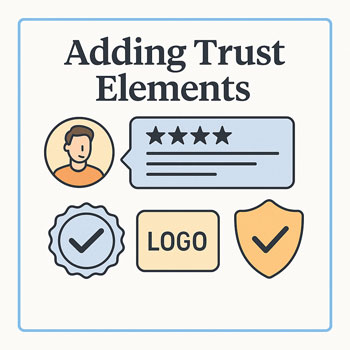
Adding Trust Elements (Testimonials, Logos, Badges)
Learn how to use trust elements—such as testimonials, review badges, media logos, certifications, and awards—to increase credibility, reduce hesitation, and improve conversions on your website.
Learning Objectives
- Understand why trust elements are essential for building credibility.
- Learn the main types of trust elements and where to use them.
- Create and format testimonials for maximum impact.
- Add authority elements such as logos, badges, certifications, and ratings.
- Place trust elements strategically on your website to boost conversions.
Why Trust Elements Matter
Visitors decide within seconds whether your business appears trustworthy. Trust elements help reassure them by showing proof that you are legitimate, credible, and capable.
Benefits of Strong Trust Signals
- Increase conversion rates.
- Overcome skepticism and hesitation.
- Build authority and professionalism.
- Show real-world results and experiences.
- Differentiate your business from competitors.
Types of Trust Elements
1. Testimonials
- Short quotes from satisfied clients.
- Video testimonials (high-impact).
- Case study excerpts.
2. Logo Bars
- Client logos
- Partner logos
- “As Featured In” media logos
3. Badges & Certifications
- Industry certifications
- Awards & accreditations
- Security badges (SSL, payment processors)
- Review platform badges (Google, Yelp, Trustpilot)
4. Ratings & Social Proof
- Google star ratings
- Customer counts (“Over 400 clients served”)
- Years of experience
- Social media follower counts (optional)
How to Create Effective Testimonials
A great testimonial is specific, believable, and highlights a transformation or result.
Elements of a Strong Testimonial
- Name + Photo (adds authenticity)
- Short quote (1–3 sentences)
- Specific result (what changed?)
- Context (industry, service used)
Example Testimonials
“Working with this team completely transformed our online presence. Our website now brings in more leads than ever before.”
— Sarah L., Small Business Owner
“Fast, professional, and extremely knowledgeable. I trust them with all of my design projects.”
— Mark D., Marketing Consultant
Tips for Displaying Testimonials
- Use 3–6 testimonials on important pages.
- Use a slider or grid layout for visual clarity.
- Mix short and long testimonials.
- Include video testimonials when possible.
Using Logo Bars
Logo bars quickly communicate authority through well-known brands or credible partnerships.
Logo Bar Ideas
- Clients you’ve worked with
- Brands you’ve partnered with
- Publications that featured you
- Tools or platforms you’re certified in
Tips for Logo Bars
- Use grayscale logos for clean, modern design.
- Keep spacing consistent.
- Add alt text for accessibility.
- Place near top or mid-page for maximum visibility.
Badges, Certifications & Awards
Badges act as instant proof of reliability and expertise.
Examples
- Google Reviews “5.0 ★★★★★” badge
- Industry memberships (e.g., Chamber of Commerce, trade associations)
- Professional certifications (e.g., Adobe, HubSpot, Microsoft)
- Security badges (SSL, McAfee Secure, Verified Payments)
- Awards (“Best Web Design Agency 2024”)
Where to Place Badges
- Homepage hero or above-the-fold
- Footer section
- Service pages
- Checkout or contact pages
Where to Place Trust Elements
Strategic placement increases credibility at key decision points.
Recommended Placement
- Homepage: Testimonial slider + logo bar
- Service Pages: Testimonials related to that service
- About Page: Certifications and awards
- Contact Page: Ratings or badges for reassurance
- Landing Pages: Reviews near CTAs
- Checkout Pages: Security badges, trust labels
Best Practices for Using Trust Elements
- Keep logos and badges visually consistent.
- Use real testimonials—not stock names or fake reviews.
- Update testimonials regularly.
- Don’t overcrowd pages; use clean spacing.
- Use proof that reinforces your messaging and services.
- Ensure images are high-quality and optimized for web.
Activity: Add Trust Elements to Your Site
- Collect 3–5 real testimonials from past clients or customers.
- Create a logo bar using client or partner logos.
- Add at least 2 badges or certifications relevant to your business.
- Place trust elements on:
- Homepage
- Services Page
- Contact Page
- Test the layout on mobile to ensure spacing and readability.
Deliverable: Upload screenshots of your added trust elements and where they appear on your website.
